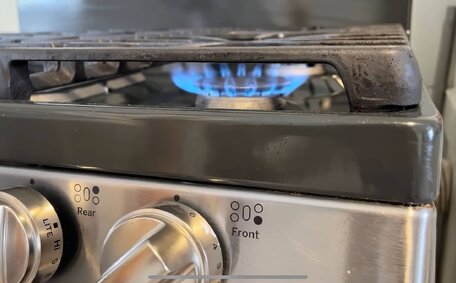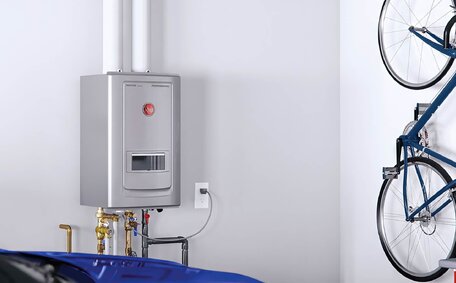Cooking with Precision and Control
Cooking with gas appliances allows for superior temperature control compared to electric or induction cooktops. This level of control is crucial for techniques like stir frying, pan roasting, broiling, or charring vegetables. Gas makes it easy to maintain low or high heat for an extended time.
The open flame provides instant heat adjustments, letting you precisely dial in the right temperature for searing, simmering, or anything in between.
With an electric cooktop, the heating element cycles on and off to regulate temperature. Gas provides consistent heat across the entire pan surface for even cooking results. With an electric cooktop, the heating element cycles on and off to regulate temperature.
This can lead to uneven cooking.
This precision and responsiveness gives gas cooktops versatility that makes them a fixture in many professional kitchens. Gas ranges allow chefs to master advanced cooking techniques. Home cooks can benefit from that same level of control in their kitchen for exceptional results.
Achieving Ideal and Even Heat Distribution
One of the main benefits of cooking with gas stoves is their ability to distribute heat evenly across pots and pans.
Gas burners heat cookware directly through an open flame. This allows all areas of the pan to receive uniform heat exposure. Even heat distribution leads to food cooking at consistent rates for optimal results.
With electric and induction cooktops, only the pan bottom makes direct contact with the heating element.
Heat travels gradually from this hot spot upwards through the sides. Heat travels gradually from this hot spot upwards through the sides. This uneven heating causes food to cook inconsistently.
Gas stoves largely avoid this problem thanks to their open burners heating cookware360 degrees. Food cooks through at the same pace for tender interiors and crisp, golden exteriors. Even heating also prevents hot spots that can burn food or cause pans to warp over time.
The efficiency of gas stoves’ heat distribution allows for quicker cooking without the need for higher temperatures. This retains more moisture and flavour compared to overcooking food on a slow-to-heat electric cooktop. Next time you use your gas stove, notice how the pan surface remains at a uniform temperature for perfect results.
Speed and Convenience
One of the main benefits of cooking with gas is the speed and convenience it offers. Gas stoves and ovens heat up significantly faster than their electric counterparts. This allows you to start cooking sooner, saving precious time in busy households.
Where an electric cooktop may take 5-10 minutes to reach cooking temperature, a gas burner will be ready in under a minute. This rapid heating is perfect for tasks like boiling water for pasta or blanching vegetables. The quick start-up means you don’t have to plan as far ahead.
This convenience continues as you cook. Adjusting stove temperatures is instant with the turn of a dial, unlike electric models where you must wait for elements to heat or cool. The responsive heat control makes gas ideal for quick cooking techniques like stir frying.
Gas stoves work during power outages when electric models become useless. This reliability provides peace of mind that you can cook hot meals no matter the circumstances.
The speed and ease of gas lends itself well to the busy modern lifestyle. Whether you’re cooking family dinners or preparing elaborate dishes, gas stoves and ovens will have you serving up meals faster.
Reliability During Power Outages
One of the most valuable benefits of gas stoves and ovens is their ability to operate during power outages when electricity is disrupted. Gas appliances run independently of the electrical grid since they rely on natural gas piped directly into the home. This allows cooking to continue uninterrupted when the lights go out.
During storms, blackouts or other emergencies that knock out power, households with gas stoves can still cook hot meals. This reliability provides vital preparation flexibility when electric ranges, cooktops and ovens become unusable without power. Gas allows you to maintain normal cooking schedules regardless of the circumstances.
Being able to boil water, bake, broil, saute and perform other cooking techniques despite power disruptions provides peace of mind. You don’t have to worry about being left unable to prepare food in these situations if you have a gas-powered stove.
Gas appliances offer redundancy against potential electrical failures. Rather than scrambling for an alternative way to feed your household during an outage, you can count on your gas stove’s resilient operation.
Some gas stoves even feature a small electric starter, providing a backup ignition source. This demonstrates the resilience of gas appliances to function reliably with or without mains electricity. Next time the power goes out in your area, you’ll be thankful for the cooking capabilities of your trusty gas stove.
Cost and Energy Efficiency
Cooking with gas is often the most cost-effective and energy-efficient option for household stovetops and ovens. Gas appliances generally use less energy than electric models for equivalent tasks. This translates into reduced utility bills, saving money in the long run.
Boiling water on a gas stove consumes around 40% less energy according to U.S. Baking a chicken for 90 minutes uses 10% less gas than electricity. Over months and years, these efficiency advantages add up through lower energy bills.
government data.
Upfront, gas stoves and ovens are typically cheaper to purchase than their electric counterparts.
Replacement gas cooktops start under $500 for home models. Gas ovens are also very competitively priced. This makes gas appliances accessible for most budgets.
In addition, gas stoves tend to have lower operating and maintenance costs. Their simpler mechanical construction requires less repairs over time compared to finicky electronics in electric models. You’ll also avoid replacement costs of electric heating elements which deteriorate with heavy usage.
Choosing gas represents a smart, value-focused decision for households looking to maximise cooking utility while minimising costs. With greater efficiency, lower purchase prices and reduced operating costs, gas stoves provide outstanding functionality per dollar spent.
High Heat Output and Versatility
One of the standout features of gas stoves is their ability to reach very high heat outputs. Open gas burners can rapidly produce intense heat up to 18,000 BTU – far hotter than any electric element. This raw heating power opens up versatility for specialty cooking tasks.
The extreme temperatures of a gas burner allow wok cooking at authentic, super-hot levels. Proper stir frying in a wok requires temperatures above 700°F to sear ingredients while retaining interior moisture. Only the intense heat of gas can properly stir fry.
Likewise, gas excels at slab grilling techniques like using a plancha grill pan or cast iron skillet to char vegetables, meat, or fish over direct high heat. You can also char peppers, tomatoes, citrus and other produce right over an open gas flame.
Gas cooking means easier flash searing of meats like tuna, steak, or chicken skin to create caramelization and texture. The heat intensity also allows for specialty techniques like blackening fish or Cajun cooking.
High-output gas burners rapidly achieve the level of heat required for boiling, steaming, pressure cooking, canning and preparing stocks, broths and soups. Heating large quantities of liquid is faster and more energy efficient on gas.
From a simmer to an intense inferno, gas stoves provide the full spectrum of temperatures to master any cooking technique. Harness all that heat output for regional dishes, flavour development, recipe experimentation and your next culinary success story.
Lower Emissions Compared to Other Fuels
One environmental benefit of natural gas and liquid petroleum gas (LPG) appliances is they release less greenhouse gas emissions compared to other fossil fuel options when used for cooking.
Burning natural gas emits nearly half as much carbon dioxide (CO2) as coal per unit of energy. LPG produces around 15% less CO2 than fuel oil or kerosene when generating an equivalent heat output.
This makes natural gas and LPG the least emissions-intensive fossil fuels. Choosing gas appliances over electric models powered by coal-fired electricity also reduces associated CO2 emissions.
Gas stoves specifically produce minimal pollutants indoors when properly vented outside via stove vents or external-facing range hoods. This maintains clean indoor air quality in the kitchen.
The lower emissions profile of natural gas and LPG provides environmental advantages over other traditional fuel options. While not emissions-free, gas appliances offer a step in the right direction for households looking to reduce their carbon footprint.
Preferred by Professional Chefs
When it comes to cooking equipment, professional chefs overwhelmingly prefer gas appliances. In commercial kitchens where speed, precision and versatility are paramount, gas is the dominant energy source for stoves, ranges and other cooking equipment.
The instant temperature response of gas allows chefs to perfectly execute cooking techniques like searing, simmering or pan frying. They can make rapid adjustments to fine-tune the heat as needed. This level of control enables mastery of the stove to create restaurant-quality results.
The powerful output of commercial gas stoves also provides chefs the extreme heat they often rely on for speciality cooking methods. They can blast woks up to 700°F for proper stir frying or char flavours onto meats and vegetables.
Chefs trust the reliability of gas appliances to continue functioning through busy services without interruption. The open burners evenly heat pots and pans from all sides for consistent results under pressure.
For household cooks, this preference is a strong endorsement of the usefulness of gas stoves. If gas is good enough for experts cooking over hot stoves all day, it will unlock exceptional outcomes in your home kitchen as well.






